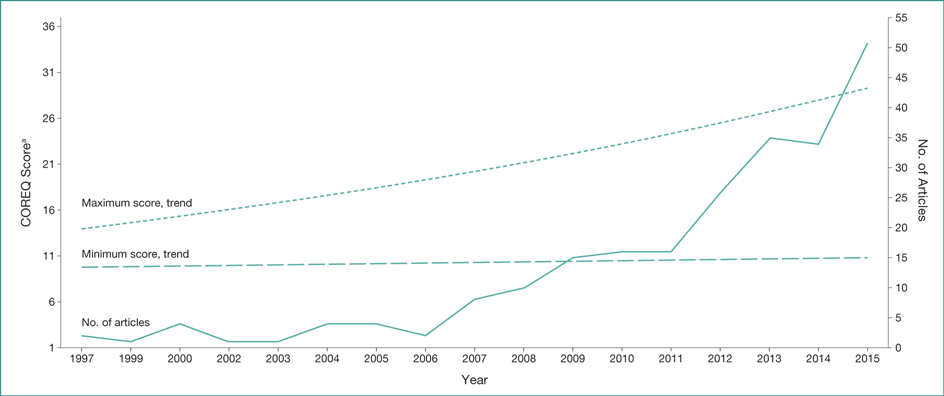Abstract
Completeness of Reporting in Indian Qualitative Public Health Research: A Systematic Review of 20 Years of Literature
Myron A. Godinho,1 Nachiket Gudi,2 Maja Milkowska,3 Shruti Murthy,4 Ajay Bailey,5 N. Sreekumaran Nair6
Objective
To systematically review the completeness of reporting in published, qualitative public health research (QPHR) studies in India.
Design
An electronic search was conducted in PubMed, Ovid MEDLINE, Web of Science, SCOPUS, and GoPubMed to identify English-language primary QPHR studies from India, published between January 1, 1997, and June 30, 2016. Study selection was based on title, abstract, and full-text reviews. To assess included articles, the following modifications were made to the Consolidated Criteria for Reporting Qualitative Research (COREQ) checklist: item 9 was subdivided into 3 subcategories (study design, methodological orientation, data collection method); item 33 was added (study limitations); and all original items were retained. All included articles were independently assessed for compliance with the COREQ checklist by 2 groups of 2 reviewers, and each item was noted as either reported or unreported. The summary included the number of COREQ items reported by each study and the number of studies that reported each COREQ item. Descriptive statistics for each year and for pre- and post-COREQ time periods were reported.
Results
Following assessment of 893 citations, 246 articles were included. Trends demonstrated an increasing number of Indian QPHR studies being published annually and an increasing maximum number of COREQ items reported over the last 20 years (Figure). However, there was no increase in the minimum number of reported COREQ items over this period. Only 2 COREQ items (study design, and data collection method) were reported in all 246 studies. More than half of the studies reported 16 to 21 of the overall 37 items. The least-reported items (reported in <10% of studies) were mention of repeat interviews (1.6%), specification of reasons for nonparticipation (2.8%), review of interview transcripts by participants (4.5%), description of coding tree (6.1%), relationship establishment prior to study commencement (8.1%), and participant checking (8.9%). Despite a net percentage increase in reporting in all 3 domains after the introduction of COREQ (in 2007), domain 1 (research team and reflexivity) was least-frequently reported, with the least percentage improvement.
Figure. COREQ Scores and Number of Indian QPHR Articles by Year (1997-2015)
aThe Consolidated Criteria for Reporting Qualitative Research (COREQ) score assigned to an article directly corresponds to the number of items reported in that article.
Minimum and maximum score trends indicate linear time trends in the lowest scored article and the highest scored article in a given year. QPHR indicates qualitative public health research.
Conclusions
Most studies reported approximately half of the recommended items. Despite improving trends, the reporting of QPHR in India is far from complete. The interviewers, context, and analysis can all affect study conclusions, and hence should be reported. Authors, journal editors, and other involved individuals should collaborate to ensure adherence to established reporting guidelines, with attention focused on the least-frequently reported areas.
1Public Health Evidence South Asia (PHESA), Manipal University, Manipal, India, myrongodinho@gmail.com; 2School of Allied Health Sciences, Manipal University, Manipal, India; 3Maastricht University, Maastricht, the Netherlands; 4Public Health Evidence South Asia (PHESA), Manipal University, Manipal, India; 5Population Research Centre, Faculty of Spatial Sciences, University of Groningen, Groningen, the Netherlands; 6Public Health Evidence South Asia (PHESA), Department of Statistics, Manipal University, Manipal, India
Conflict of Interest Disclosures:
None reported.
Funding/Support:
No funding was provided or obtained for any part of this study.
Acknowledgments:
We would like to acknowledge Public Health Evidence South Asia (PHESA), and Manipal University for providing the infrastructural support necessary to conduct this research.

